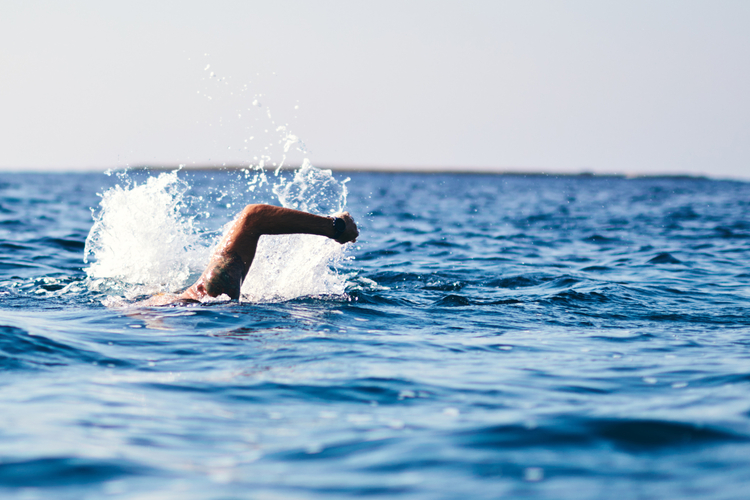
Swiss swimmer Noam Yaron’s epic 102-hour crossing shows the extremes of ocean endurance, Tristan Kennedy reports
Everything about Noam Yaron’s swim was meticulously planned. Completing the 180-kilometre route from the island of Corsica to the Principality of Monaco would take five days, he estimated. This would mean surpassing the existing world record for the longest time spent swimming in salt water.
But he had attempted the trip the previous year, only to be beaten by inclement weather at the 48-hour mark. So when he got back into the water on 11 August 2025, he was especially well prepared.
Enjoying this article? Check out our related reads:
He had two boats following him closely. ‘One was just for performance, with a platform set in the water that holds all my drinks, nutrition and everything,’ he explained over a video call from his home in Switzerland at the beginning of September.
The other served as backup, but also to conduct scientific experiments. Yaron’s swim took him across the Pelagos Sanctuary, a marine nature reserve, and was aimed at raising awareness of the lack of protection for marine wildlife in this supposedly protected area. The second boat gathered hard data on plankton health, water quality and other metrics to support his case.
Yaron’s team included trainers, medical support and social media experts. They even went as far as pre-recording Instagram videos to post as he made the crossing.
‘If you’re seeing this, it means I’ve been swimming for 103km, which is where I stopped last time…’ he says in one. Yaron knew – not least from his prior experience – that prolonged exposure to salt water would take a toll on his body. What he had not planned for was spending nine days in hospital afterwards.
‘They treated me for multiple reasons,’ he said – each compounding the others. The salt he breathed in (an unavoidable consequence of sea swimming) had begun to saturate his lungs, causing his blood oxygen levels to drop precipitously. ‘According to the doctor at he hospital in Monaco, I shouldn’t still be breathing with those oxygen levels,’ he said. ‘The second problem was my liver.’ Prolonged exposure to salt water meant it was hugely inflamed. ‘They did a blood test suggesting my liver was almost gone,’ he added.
He was almost hypothermic when he emerged from the water, despite wearing a wetsuit. And the suit itself had become so encrusted with salt that it rubbed second-degree burns around his arms, legs, knees and neck. ‘It burned approximately 15 per cent of my body,’ he said. ‘It’s the worst pain I’ve ever experienced in my life.’
A pain so intense, particularly as his dressings were changed, that it cut through the painkillers he was given. He showed me the angry red marks around his neckline, still visible even two weeks after he was discharged.
Then there were the cognitive issues. As Yaron swam, he experienced hallucinations, including seeing castles in the air and apparently visiting countries he had never been to.
This was not unexpected. It’s a consequence, he said, of ‘exhaustion and sleep deprivation’, intensified by his low blood-oxygen levels – and his team were keeping careful tabs on him. But there were question marks over any long- term damage. On his fourth night in the water, a blue shark swam within a metre of him, and as his team debated whether the shark’s behaviour was threatening – at which point they had agreed they would pull him out of the water – Yaron barely knew what was going on.
Thankfully, in hospital, ‘they did a lot of tests on my brain and everything is fine.’ But as he lay in his hospital bed, and his pre-planned ‘if you’re watching this…’ videos dried up, Yaron’s army of online supporters began to worry.
On 26 August, ten days after finishing the swim, he appeared on camera again. He had actually swum 191.17 kilometres – 11 kilometres more than the 180 he had envisaged – because currents and other factors had moved him off course, he explained.
He had been in the water for an incredible 102 hours and 24 minutes, and made it to within two kilometres of Monaco harbour. He had spent his last five hours basically just floating, trying to get his head straight and muster the strength for a final push. But then he had what he describes as a near-death experience. And ‘that was the moment that truly got my team to say, “Okay, that’s enough”,’ he said.
‘I started leaving my body and hearing voices saying, “It’s fine, you’ve done
the best you could,” and I was like “No, this is not going to be okay!”’ Using the determination that had got him that far, Yaron dragged himself back into the present, and agreed to calling it quits – a decision that, in hindsight, saved his life.
Despite it being such a close-run thing, Yaron is incredibly happy with how it all went (the hospital stay and the excruciating pain aside). The swim was a personal goal he had been building up to for years – ever since he swam the length of Lake Geneva in 2021.
But it also smashed its target of raising awareness of the issues around ocean protection – particularly in the Mediterranean, one of the most heavily trafficked and polluted seas in the world. Yaron is now officially an ambassador for the Together for the Ocean campaign, a group of 25 NGOs working to drive action on the ‘30 by 30’ goal, which aims to have 30 per cent of the world’s seas designated as genuinely protected areas by 2030.
The incredible story of his record-breaking swim, he said, ‘reached 60 million people during those five days and five nights – which is like the entire population of France.’ As the story continues to spread, so will Yaron’s message. And that, regardless of anything else, was exactly what he had planned.
Wishlist – three items that will help make ocean swimming a pleasure, not a pain
The Luxury: Finisterre Sea Suit, £150

The Sea Suit is a brilliant invention from Finisterre, the Cornwall-based company that first made its name with high-quality, low-impact surf clothing and accessories.
Designed by women on the Finisterre product team, specifically for women, it’s an antidote to figure-hugging swimsuits and revealing bikinis.
The fit is secure and elasticated around the neck and cuffs, but loose enough that it can be worn over a wetsuit if desired. The geometric print is designed to camouflage the contours of the body, and the whole suit is made from recycled polyester fabric to help keep its environmental footprint low. If you prefer to cover up when swimming, the Sea Suit is for you.
The Surprisingly Useful: Waterproof Gear Case, £40

While you don’t need a fully waterproof crossbody bag with an easy-opening magnetic closure to go ocean swimming, it’s a real ‘nice to have’. It’s designed to be big enough to hold your phone, wallet and any other essentials you don’t want to get wet.
And sure, you could use a conventional dry bag, but they are fiddly to unroll and unclip every time you want to check why your phone is buzzing.
Originally built with fishermen and boat-owners in mind, this will suit anyone who spends long periods in, on or near the water – especially salt water, which can rapidly destroy even the most modern waterproof phones.
The Essential – Rooster Changing Mat Bag, £35

We can all use a changing mat, and a waterproof bag is also pretty useful. The Changing Mat Bag from British brand Rooster Sailing combines the two. The changing mat base allows you to get changed without spiking your feet on sharp rocks or getting sand stuck to them.
When you have your wet kit off (wetsuit, tow float, towel) simply pull the drawstring and the waterproof fabric will hold everything inside.



